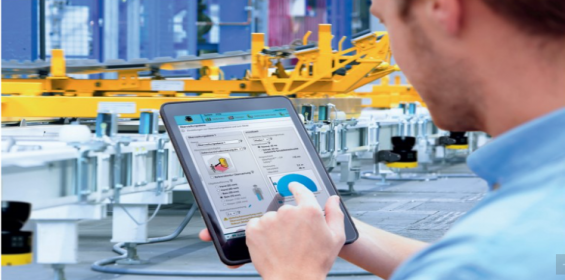Sensors have become intelligent and programmable tools for enterprisewide business improvement. Meanwhile, the practice of digital twinning is fast becoming a mainstream monitoring technique that can get you right into the workings of a machine without having to lay a finger on it.
Sensors are the windows into this virtual world; they connect the physical with the virtual. With the right systems in place to visualise and route the data effectively, sensor data can be used, horizontally, to track the progress and efficiency of processes and, vertically, to drill down into the health of the operating assets, from the cloud right into heart of a machine.
For engineers, and indeed for manufacturers like SICK for example, the role of sensors is being rapidly redefined. Our customers no longer just ask us to help them solve classic automation problems to do with engineering sensors, actuators and logic. They want to know: how do I make the most of all this data that the sensor has gathered? How do I best use it to make my product, machine or process more available, responsive and efficient?
On the factory floor, manufacturers are looking for ways to adopt Internet of Things Process, Controls & Plant Focus on: Sensors & Measurement (IoT) technologies to create a digitallyconnected virtual representation of their operations. How can the condition of machinery be monitored in the cloud to recognise if a motor is running too hot; if a belt drive is vibrating too much, if a quality inspection system is generating too many rejects, or simply to know when it’s time to replace a component before it becomes worn and fails?
3D model
Most people recognise the concept of a digital twin that begins with building a 3D model of a facility. But the danger with starting with a 3D model is that it could easily become a pet project for senior operations or enterprise management, rather than a valuable tool in the hands of engineers and operators. Yet, much of the data generated by, and about sensors, is of most use to those on the front line, looking after the assets day by day.
Neil Sandhu, national product manager for SICK UK, says his company favours a modular process that enables you to start from the identification and knowledge of every asset, through a scalable asset management system, right through to the live pairing of the sensor with the cloud. This step-by step approach puts information at the fingertips of engineers, while still generating data for use in operations-wide or enterprise-level management tools.
He explains that you can choose to start simply, just by using a smartphone App to create a virtual representation – a digital twin in the simplest sense – of each of your devices: “Simply tag the 2D code label and begin to collect data on your entire installed sensor inventory. The App, called the SICK Installed Base Manager, automatically detects and logs the serial number and age of the device, assigns it to the machine and plant, and provides an option to add photos and the exact GPS location. You can add non-SICK devices, too. Authorised employees can interrogate and update the Installed Base and add new devices at any time.”
Asset management
Having created a Digital Twin of your real device, you have the beginnings of an asset management system that can then be viewed and managed in the cloud. Sandhu, explains that the SICK Asset Hub is the company’s foundation asset management service that is vendor-independent and modular and enables any type of asset to be mapped: “Data can be evaluated so that maintenance happens at the right time, software and firmware are up to date, and that inventories are well planned and optimised. Additional data and documents can be easily stored and retrieved for any asset. You can navigate via a tree structure of your functional locations to view a broad range of asset-related information and documents along the life cycle.”
He adds that using the Live Connect module you can pair your real device with its virtual representation to achieve secure, live data transmission between the sensor and the cloud. You can manage the routing and forwarding of data to other applications or third-party dashboards: “Using Live Connect, a secure, standardised and easy-to-use live data connection is achieved from each sensor into the Asset Hub, via an edge gateway device. Not only can the sensor status be visual in the cloud, but live process data can be integrated into monitoring applications.”
No data goes to waste
There was a time when sensors were little more than simple switches taking their place in PLCdriven processes. Many still do this job very well, but we have an opportunity not only to harness additional information from the sensor that previously might have gone to waste, but to exploit it in cloud-level systems and processes.
Whether you want a simple asset tracking system, or a virtual representation of your whole factory, sensor data is becoming a valuable raw material, that can help ensure the availability and productivity of critical machine components. Why not “Keep it real” and start a step by step journey towards digital twinning today?
********************************************************************************************************
The SICK Monitoring Box is a module focused on continuous status monitoring for sensors and machines. It enables the early detection of status changes with configurable alarms that can even be set up on mobile devices. Implemented either at a customer’s premises or in the SICK cloud, any significant changes to the device status can be visualised so that operators can take timely action. There’s also a logbook to clearly record, visualise and document events.
********************************************************************************************************

